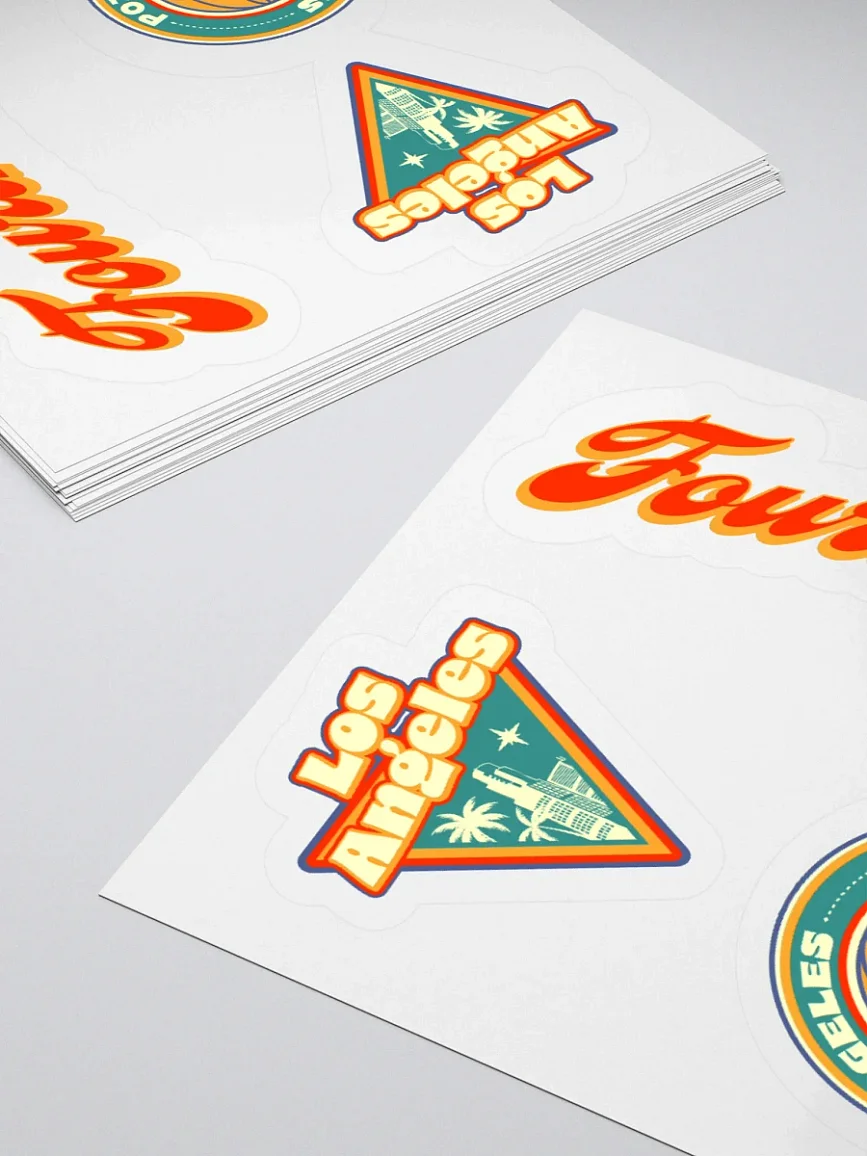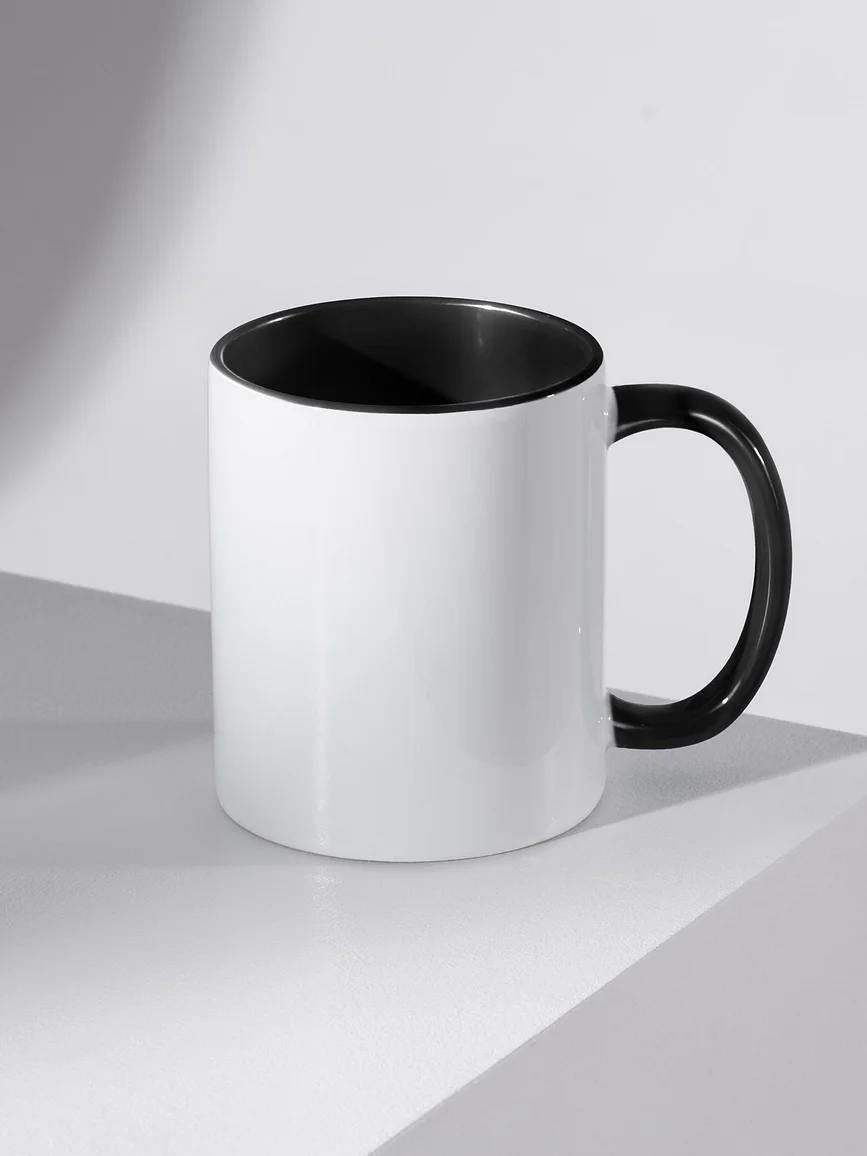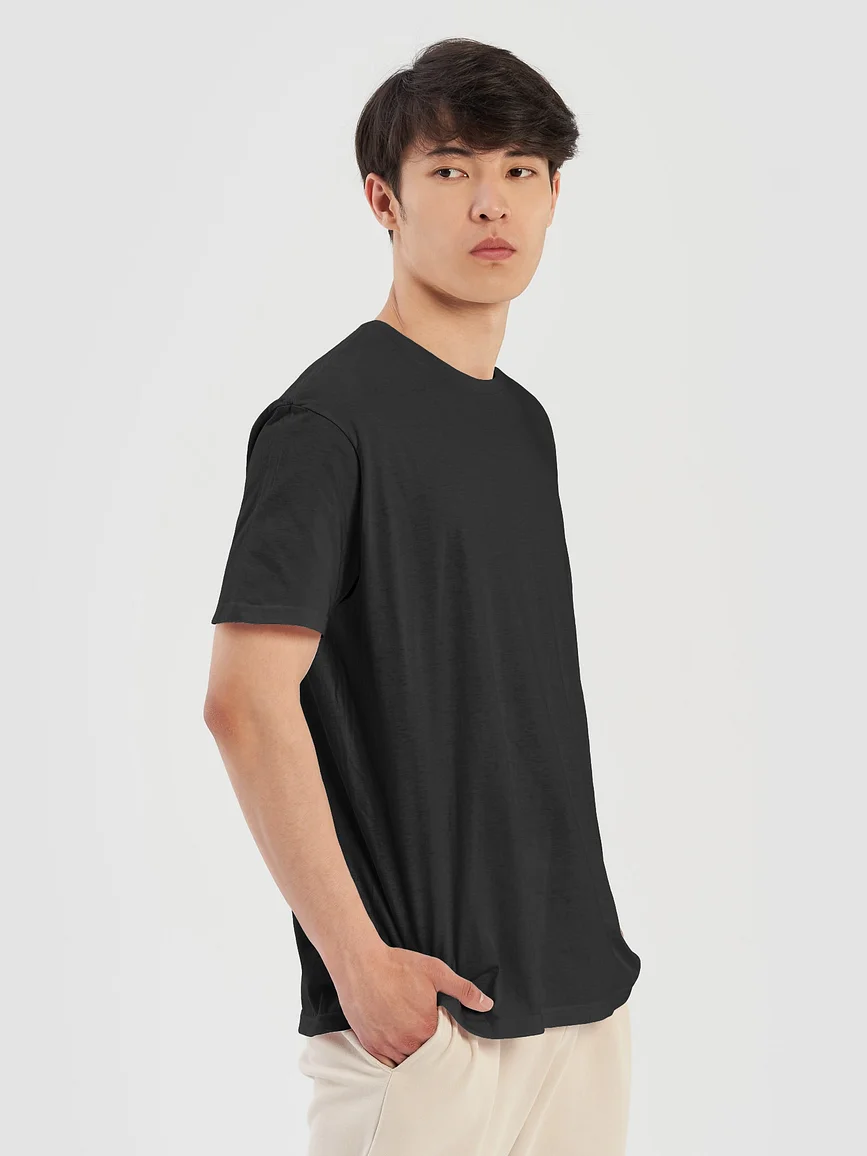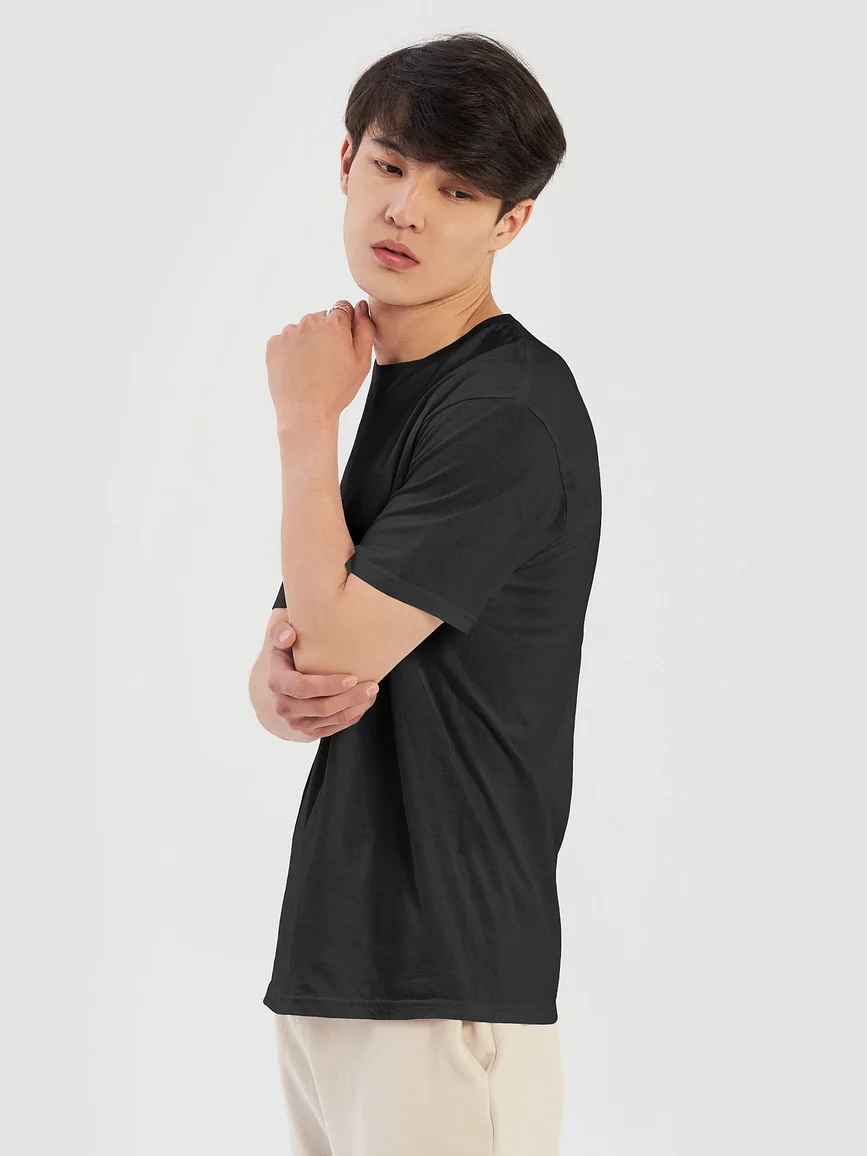13 Best Shutterfly Alternatives for Creators and Photo Enthusiasts in 2025
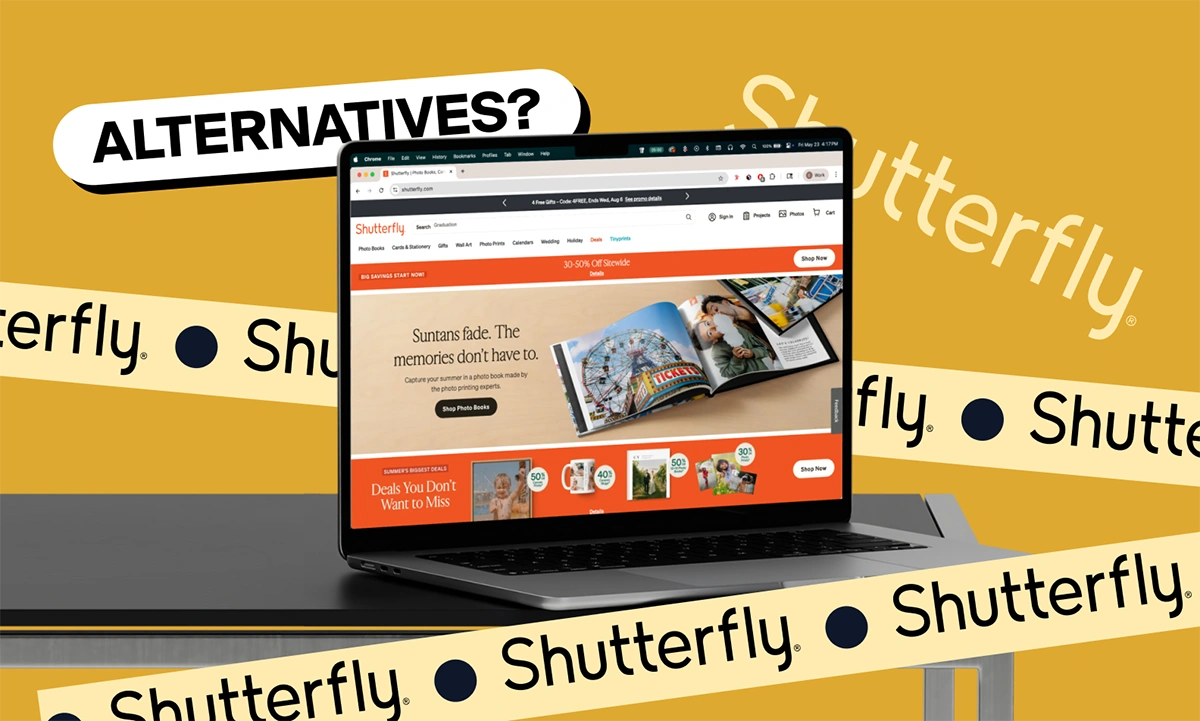
If you’ve ever created a photo book, ordered custom gifts, or browsed for personalized prints, chances are you’ve come across Shutterfly.
Known for its wide range of photo products, from layflat photo books and hardcover albums to mugs, calendars, and more, Shutterfly has built a reputation as a go-to for casual users.
But when it comes to print quality, advanced design tools, and the ability to monetize your creations, some might consider the platform to fall short.
In this article, we'll cover everything Shutterfly offers, break down its pros and cons, and explore 13 alternatives that can deliver high-quality prints, flexible layouts, and even built-in tools for selling your work online.
What is Shutterfly?
Founded in 1999, Shutterfly is one of the most widely recognized photo printing services, catering primarily to everyday users who want to turn digital memories into personalized keepsakes.
Whether you're making gifts for family, building a custom photo album, or designing wall decor, Shutterfly offers a wide range of tools that make the process simple, even if you’re not a designer.

Here’s a breakdown of the key features that make Shutterfly what it is:
📦 Wide Range of Photo Products
- Photo Books: Choose from hardcover, softcover, or layflat albums with themes for weddings, vacations, babies, and more. Customize layouts, add text, stickers, and even request a designer-made album via the Make My Album service.
- Personalized Gifts: Print your photos on mugs, blankets, pillows, phone cases, tote bags, and other household items.
- Cards & Stationery: Create custom cards for every occasion (holidays, weddings, baby showers, graduations) featuring foil-stamped, glitter, and die-cut options.
- Wall Art & Prints: Order framed prints, canvas prints, metal or acrylic wall decor, and large-format photos in a variety of paper types and finishes.
- Calendars & Home Decor: Build custom wall calendars, desk calendars, or functional decor with personal photos and notes.
🖥️ Easy-to-Use Online Design Tools
- Drag-and-Drop Editor: Customize products using pre-designed templates or build layouts from scratch.
- Themed Templates: Choose from dozens of stylish themes for photo books, cards, and prints, suited for specific events or moods.
- Basic Photo Editing: You can crop, rotate, zoom, and reposition images within templates. Just note that advanced editing (like filters or retouching) is limited.
📱 Mobile App with On-the-Go Access
- iOS and Android Apps: Upload, organize, and order prints straight from your phone.
- Free Monthly Prints & Photo Book: Get unlimited free 4x4 or 4x6 prints and a free 6x6 softcover photo book every month (shipping not included).
- Mobile Tools: Add captions, rearrange photos, and preview products directly within the app.
☁️ Unlimited Free Photo Storage
- Secure Cloud Backup: Upload and store an unlimited number of photos for free, with long-term access guaranteed.
- Cross-Platform Uploads: Add images from your computer, phone gallery, Facebook, Instagram, or Google Photos.
- JPEG Compatibility: Most uploads must be JPEG files, and there’s no built-in support for RAW or TIFF.
🖼️ Photo Book Services
- Make My Album: Submit your photos and have a professional designer create a book layout for you, free of charge.
- Customizations: Resize, move, and caption your photos. Add text, backgrounds, and stickers for a personalized look.
- Premium Upgrades: Choose higher-quality paper, denser colors, and smoother transitions for a more polished finish.
🛒 Order Fulfillment & Pricing
- Competitive Pricing: Prints start at $0.15 for 4x6 images; photo books start around $29.99 for premium hardcover versions and less for softcover.
- Specialty Products: Print on unusual items like flower pots, shower curtains, or bed linens.
- Promotions & Discounts: Frequent promo codes available for free prints, discounted shipping, and bulk order deals.
- Shipping & Packaging: While shipping can be expensive, Shutterfly is often praised for its secure packaging and reliable delivery.
Why You Might Want to Look for a Shutterfly Alternative
While Shutterfly is a solid platform for casual users looking to create sentimental gifts or photo keepsakes, it’s not always the best fit for professional creators, photographers, or anyone trying to build a brand or sell their work.
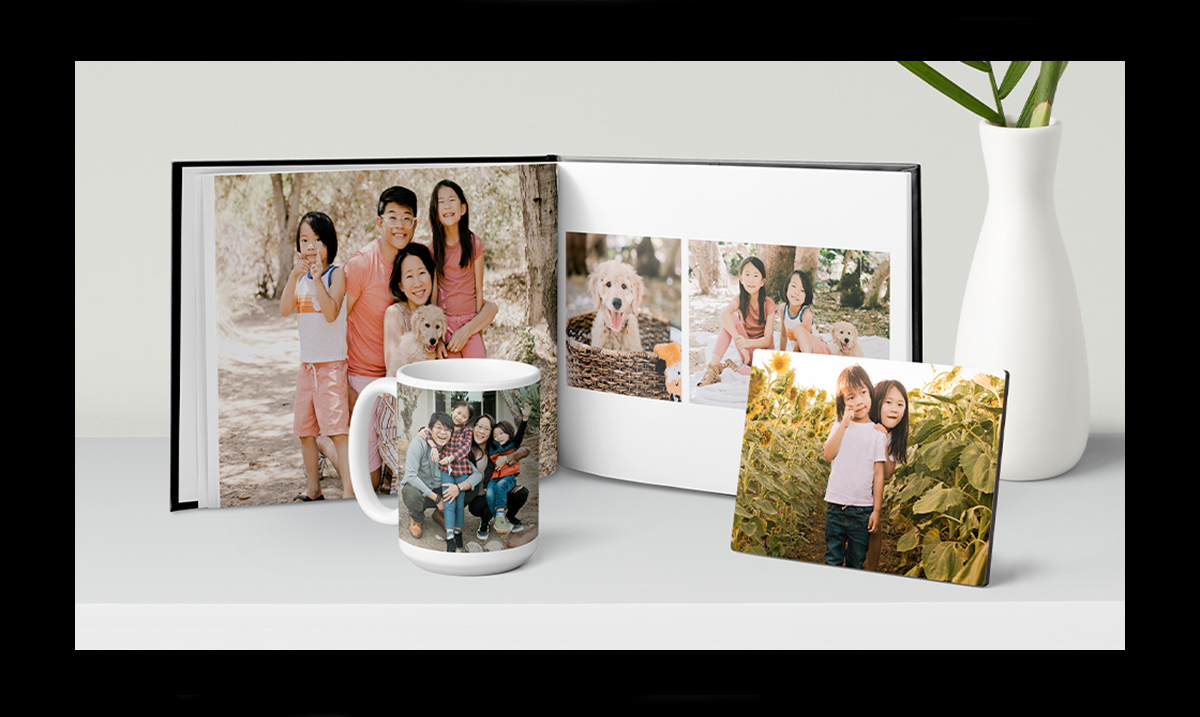
Here’s why:
🎨 Limited Creative Control
Shutterfly offers a wide range of pre-made layouts and themed templates, but for many creators, the design experience can feel restrictive.
You can’t fully customize the look and feel of your store, and while you can add text and stickers, the lack of advanced editing tools means you’re stuck with a fairly basic design experience.
For artists and photographers who care about brand aesthetics, that’s a dealbreaker.
💸 No Way to Monetize Your Work
If you're looking to sell your photos or custom designs, Shutterfly doesn’t offer any built-in ecommerce tools or sales features.
You can’t set your own prices, earn a commission, or create a branded storefront where fans can support you directly. That’s a huge miss for creators trying to build a business or generate passive income.
📷 Inconsistent Print Quality
While Shutterfly is known for its broad product catalog, print quality isn’t always consistent, especially when compared to professional-grade services like Mpix or Printique.
For photographers who rely on sharp images, color accuracy, and high-quality paper types, the end result can sometimes fall short of expectations, especially when you’re producing work for clients or galleries.
📦 High Prices & Shipping Costs
While Shutterfly frequently offers discounts, its standard prices and shipping fees can add up quickly, especially for larger or frequent orders.
For creators handling bulk orders or hoping to dropship products to fans, the platform can quickly become cost-inefficient.
Bottom line?
If you're a creator trying to grow your brand, earn income, and deliver professional-quality products, Shutterfly just isn’t built with you in mind.
Fortunately, there are plenty of other creator-focused platforms that give the freedom, tools, and earning potential you need without sacrificing print quality or control.
Top 13 Shutterfly Alternatives to Try in 2025
1. Fourthwall
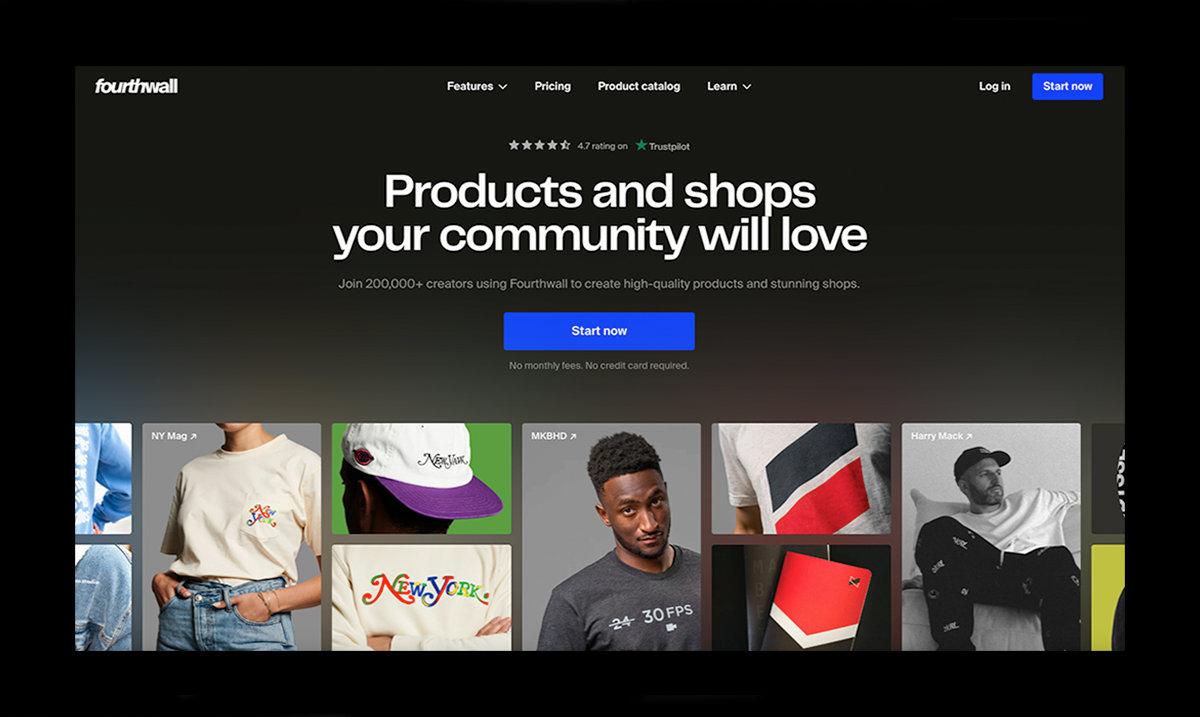
If you're a creator, photographer, or influencer looking to do more than just print personal photo gifts, Fourthwall is a powerful alternative to Shutterfly.
Instead of offering one-off prints for personal use, Fourthwall gives you a fully customizable storefront where you can sell photo prints, canvases, mugs, apparel, and even digital products, all under your own brand.
The platform is designed specifically for creators, with built-in monetization tools like fan memberships, tips, and integrations with YouTube, TikTok, and Twitch.
With zero inventory costs thanks to print-on-demand fulfillment, Fourthwall gives you total control over your pricing, product lineup, and customer experience, making it a perfect fit for creators who want to turn their content into a full-on business.
✅ Pros:
- No-code, fully branded storefront
- Sell physical and digital products
- No upfront costs (print-on-demand model)
- Built-in tools for fan engagement (memberships, tips, early access)
- Integrates with major creator platforms like YouTube, TikTok, and Twitch
- You set the prices and keep more profit
❌ Cons:
- Not ideal for casual users just looking to make one-off photo gifts
- Limited to creators with an audience or niche (not a mass consumer marketplace)
- Smaller product catalog than Shutterfly for certain specialty gift items
2. Printify

While Shutterfly is great for personal gifts, Printify is built for both personal use and business growth, letting you design and sell custom photo gifts, wall art, mugs, cards, and over 1,300+ products through your own online store.
Whether you're ordering one item for yourself or launching a full eCommerce brand, Printify gives you access to high-quality print providers, global shipping, and seamless integrations with platforms like Shopify, Etsy, and WooCommerce.
You can create pixel-perfect designs using their Product Creator, which includes tools like a graphics library, text editor, and even an AI Image Generator.
Best of all, it’s a print-on-demand platform, so you can start selling worldwide without any inventory, upfront costs, or shipping headaches.
✅ Pros:
- Massive product catalog with 1,300+ customizable items
- Print-on-demand with no upfront investment
- Seamless integration with Shopify, Etsy, and other major platforms
- Advanced design tools, including AI Image Generator and mockup preview
- Global network of print providers for faster, localized shipping
- Competitive pricing with better margins than Shutterfly
❌ Cons:
- No built-in storefront (requires a third-party eCommerce platform)
- Print quality can vary between providers and requires testing for consistency
- Lacks personal photo storage and memory-keeping features like Shutterfly
- More setup and a learning curve for beginners compared to plug-and-play platforms
3. Mixbook
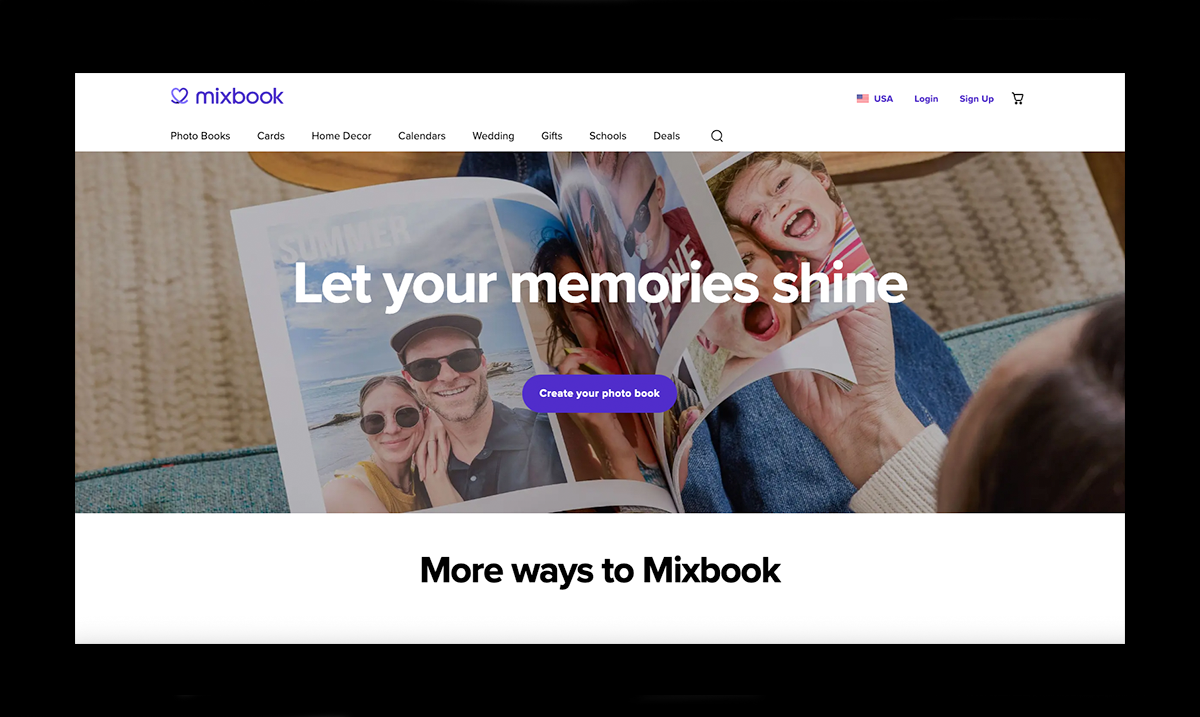
Mixbook is a standout choice for anyone looking to create a custom photo book with top-tier design tools and a premium finish.
Unlike Shutterfly, which leans on pre-made layouts, Mixbook offers far more creative freedom, letting you fully customize every page with modern templates, stylish fonts, and layout options.
Whether you're designing a wedding album, holiday cards, a layflat photo book, or personalized photo gifts, Mixbook delivers vibrant print quality, high-end paper types, and sleek hardcover options that rival platforms like Blurb, Printique, and Artifact Uprising.
Its user-friendly interface and rich customization features make it ideal for both beginners and experienced creators looking to design something meaningful and professionally polished.
✅ Pros:
- Exceptional print quality with vibrant, true-to-life colors
- Full creative control with robust customization tools
- Modern templates and flexible design options
- Wide range of photo products, including books, cards, calendars, and wall art
- Easy-to-use interface suitable for all skill levels
❌ Cons:
- Slightly higher prices than other photo printing services
- Some free templates are limited in variety
- Mixbook's logo will appear on some products unless you upgrade to remove it
- No built-in tools for selling or monetizing your designs
4. VistaPrint
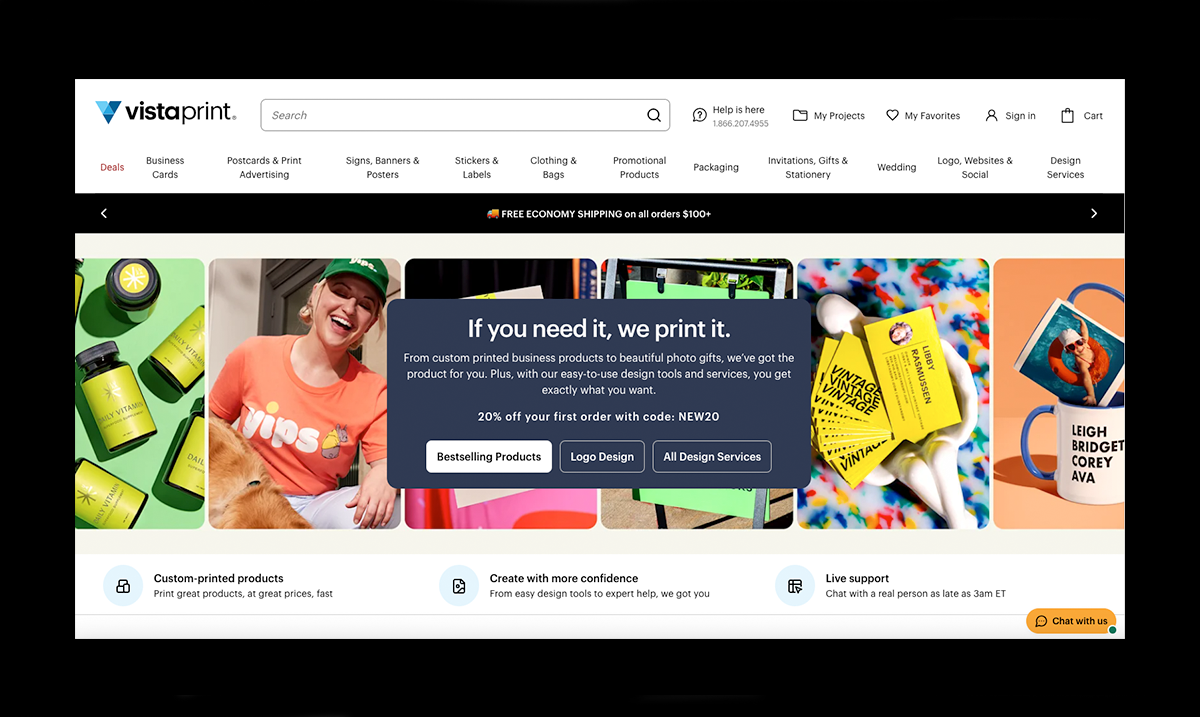
When it comes to creating sleek, professional-looking products that elevate your brand, VistaPrint stands in a league of its own.
Unlike Shutterfly’s personal gift-oriented focus, VistaPrint is designed for creators and small business owners who need marketing materials, custom merchandise, and print collateral that look sharp and cohesive.
With a massive catalog that includes everything from business cards and flyers to photo books, mugs, and calendars, VistaPrint combines high-quality printing with easy-to-use customization tools.
If your priority is building a strong brand presence rather than printing memories, then it's an ideal choice.
✅ Pros:
- Wide product selection tailored for business and branding
- Exceptional print quality and finishing options
- Intuitive design tools for fast, polished results
- Ideal for bulk orders and consistent brand presentation
- Strong customer service and support
❌ Cons:
- Slower turnaround for certain items like photo books or apparel
- Not optimized for selling products or building an online store
- Lacks advanced photo editing or creator-focused features
- No built-in fan engagement tools like tipping or memberships
5. Snapfish
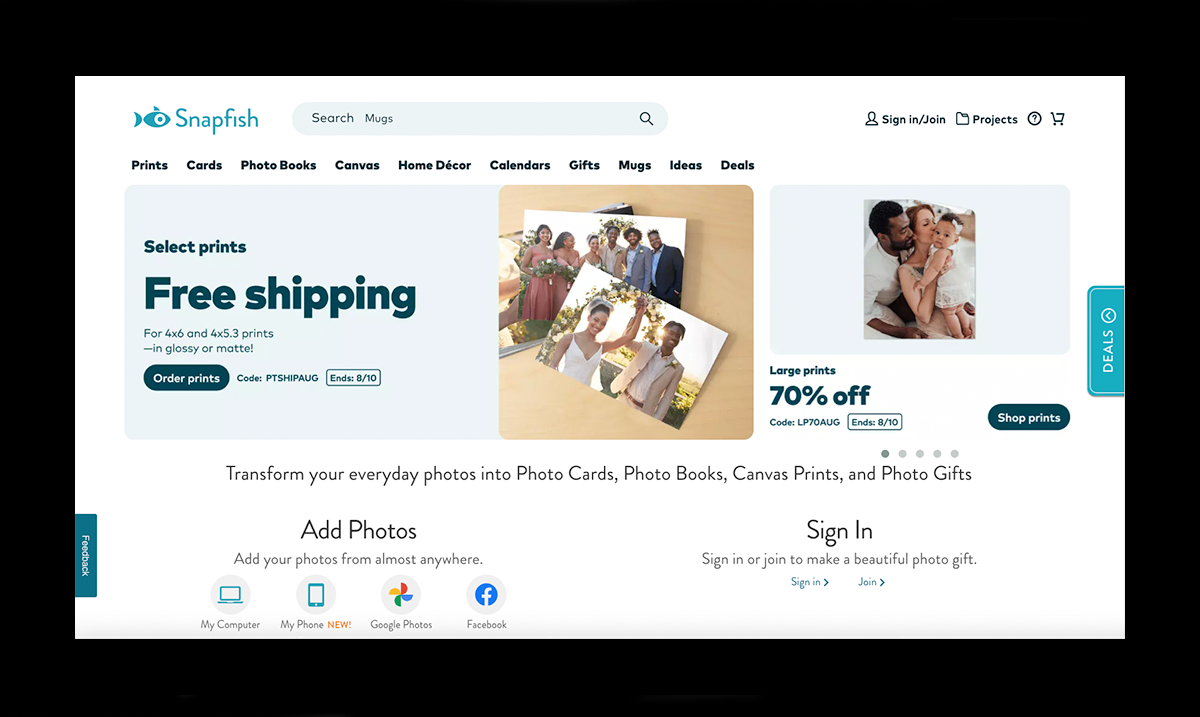
If you're looking for a budget-friendly alternative to Shutterfly, Snapfish delivers a wide range of customizable photo products without the premium price tag.
From photo books and prints to mugs, cards, and wall decor, Snapfish makes it easy to design personalized gifts using a simple, user-friendly interface.
Owned by the same parent company as Shutterfly, it offers many of the same features but often at lower prices and with frequent promotional discounts.
While it doesn’t offer the same high-end finishes or advanced customization tools as other platforms on this list, Snapfish is a solid choice for anyone who wants fast, affordable photo printing without overcomplicating the process.
✅ Pros:
- Affordable pricing with regular discounts and deals
- Wide selection of photo books, prints, gifts, and home decor
- Easy-to-use design interface, even for beginners
- Quick turnaround and fast delivery
- Ideal for personal projects or low-cost gift giving
❌ Cons:
- Print quality can vary between products
- Fewer premium finishes and paper options than competitors
- Limited advanced design or editing tools
- Less suitable for professionals or creators needing polished, brand-level output
6. Zazzle
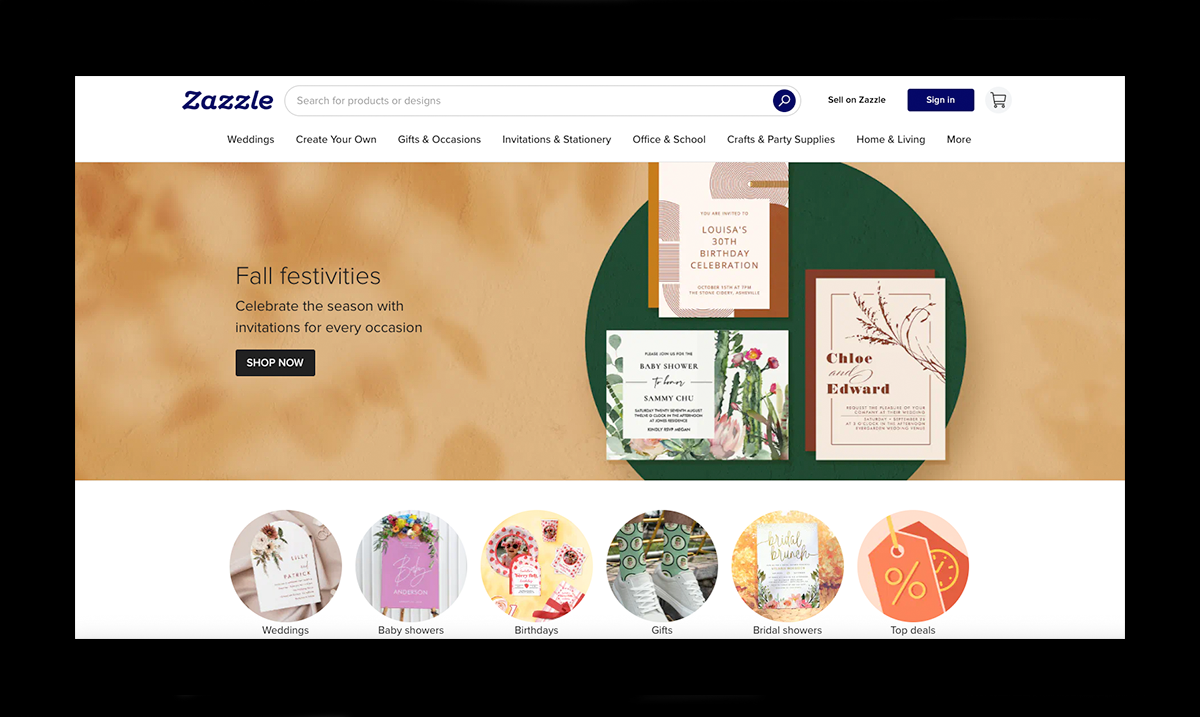
As a massive online marketplace, Zazzle empowers users to design and sell their own products, including everything from apparel and accessories to home décor, party supplies, and office gear.
Artists and designers can upload their work, customize thousands of items, and earn royalties through Zazzle’s built-in storefront, making it a great option for those looking to tap into eCommerce without managing inventory.
While it does offer a wide selection of customizable goods and a strong platform for creative expression, it’s not ideal for professional photo printing or memory preservation.
Production times can vary, and some users have noted inconsistencies in product quality. Still, for creators who want to monetize their designs or simply explore new ways to express their style, Zazzle offers flexibility and reach that Shutterfly doesn’t.
✅ Pros:
- Huge variety of customizable products, including apparel, gifts, and home décor
- Great for showcasing creativity or building a niche product line
- Built-in marketplace for selling designs and earning royalties
- Accessible design tools for beginners and hobbyists
❌ Cons:
- Print quality can be inconsistent across product types
- Website interface can feel cluttered or unintuitive
- Longer production and shipping times for some custom items
- Less suited for professional photographers needing gallery-quality prints or photo books
7. Artifact Uprising
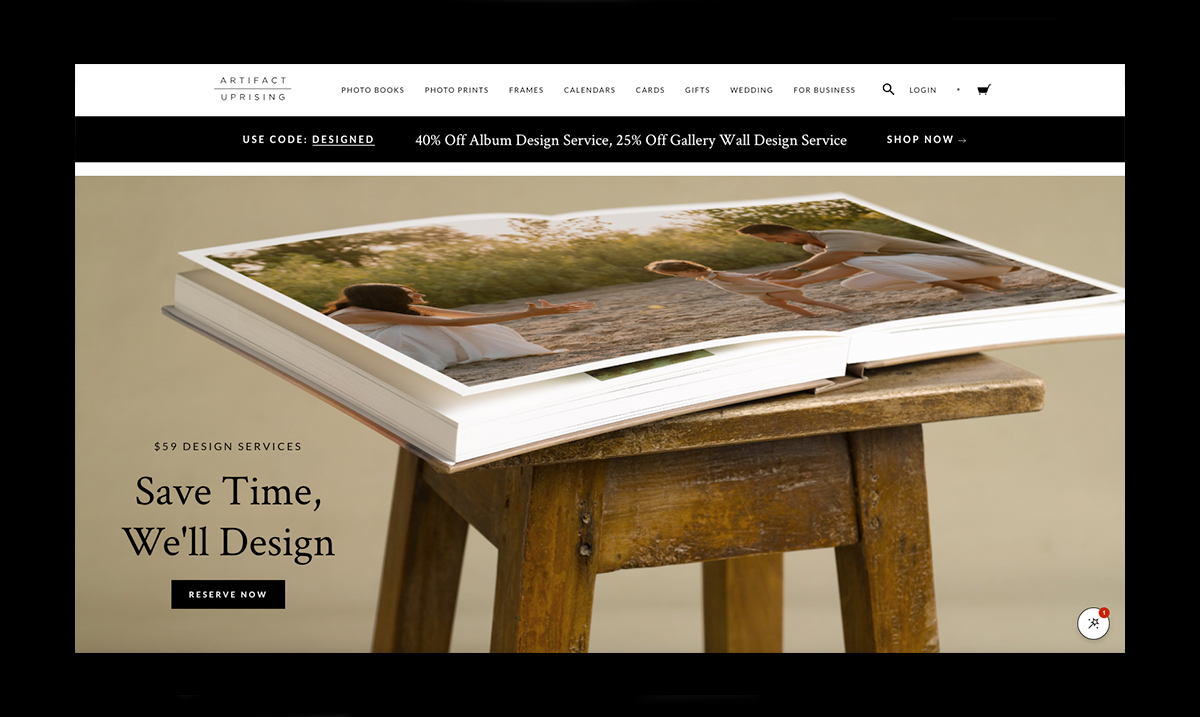
Known for its premium photo books, gallery-worthy wall art, and luxurious print quality, Artifact Uprising delivers beautifully crafted keepsakes with a minimalist, design-forward aesthetic.
Unlike Shutterfly’s mass-market feel, Artifact Uprising focuses on sustainability, using recycled paper and responsibly sourced materials to create products that look and feel timeless.
While it comes at a higher price and has a more curated product selection, it's a perfect fit for photographers, artists, and anyone who values elegant presentation and meaningful craftsmanship.
✅ Pros:
- Premium print quality with attention to design and detail
- Eco-friendly materials, including recycled paper and FSC-certified wood
- Ideal for photographers, creatives, and high-end gifts
- Elegant templates and modern layouts
❌ Cons:
- Higher price point compared to most Shutterfly alternatives
- Smaller product range (fewer gift and novelty items)
- Not ideal for bulk or budget orders
- Limited customization outside of core templates
8. Moo
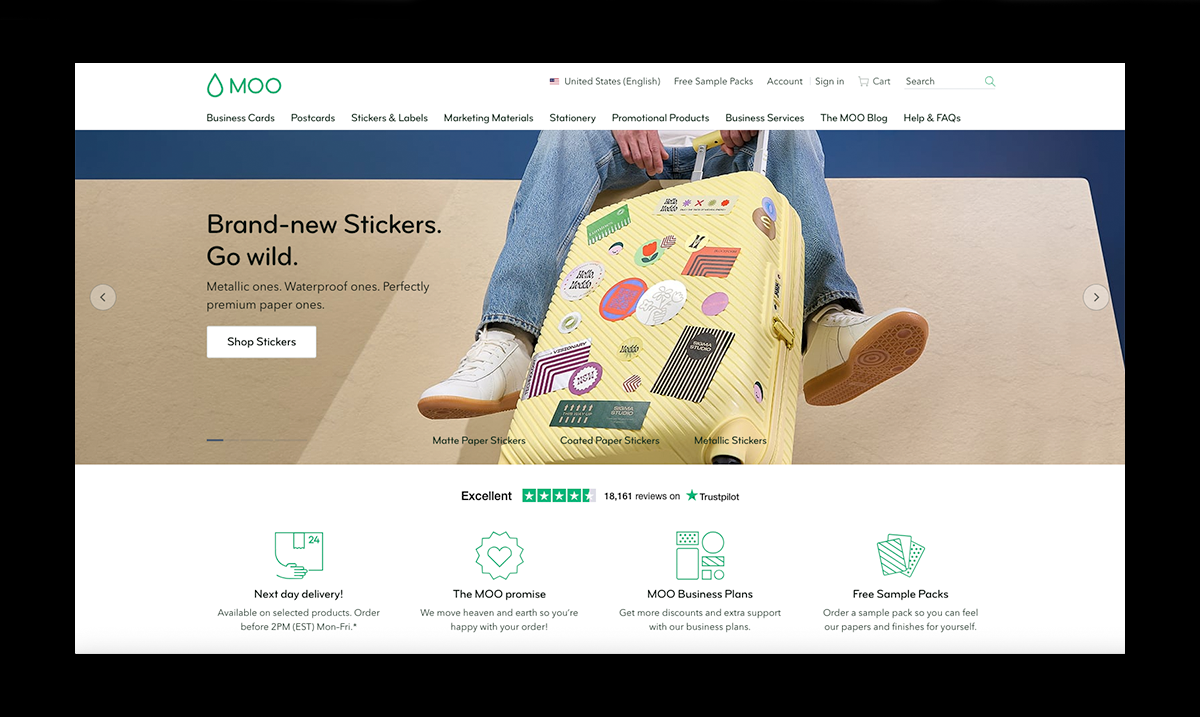
Moo is more than just a printing service; it's a full-featured custom print marketplace offering everything from business cards and postcards to branded stationery, stickers, and promotional items.
Known for its premium finishes like Gold Foil, Soft Touch, and Letterpress, Moo delivers vibrant, high-quality prints that make a bold impression.
The platform is easy to use, allowing you to upload your own designs or customize existing templates, and you can even request free sample packs to preview product quality before placing a larger order.
While it’s not ideal for creating photo albums or memory books, and has higher pricing compared to other platforms, Moo excels at producing branded content, marketing materials, and polished prints that look sharp and professional.
✅ Pros:
- Outstanding print quality with premium paper and finishing options
- Great for business cards, postcards, and branded promotional materials
- Sleek, user-friendly design experience
- Offers free sample packs for select products
- Ideal for creative professionals and small businesses
❌ Cons:
- Pricier than other printing platforms like Shutterfly or VistaPrint
- Longer production and delivery times, depending on customization
- Their product range is business-oriented and limited to personal photo printing
- Customization tools are solid but not as advanced as full design software
9. Blurb
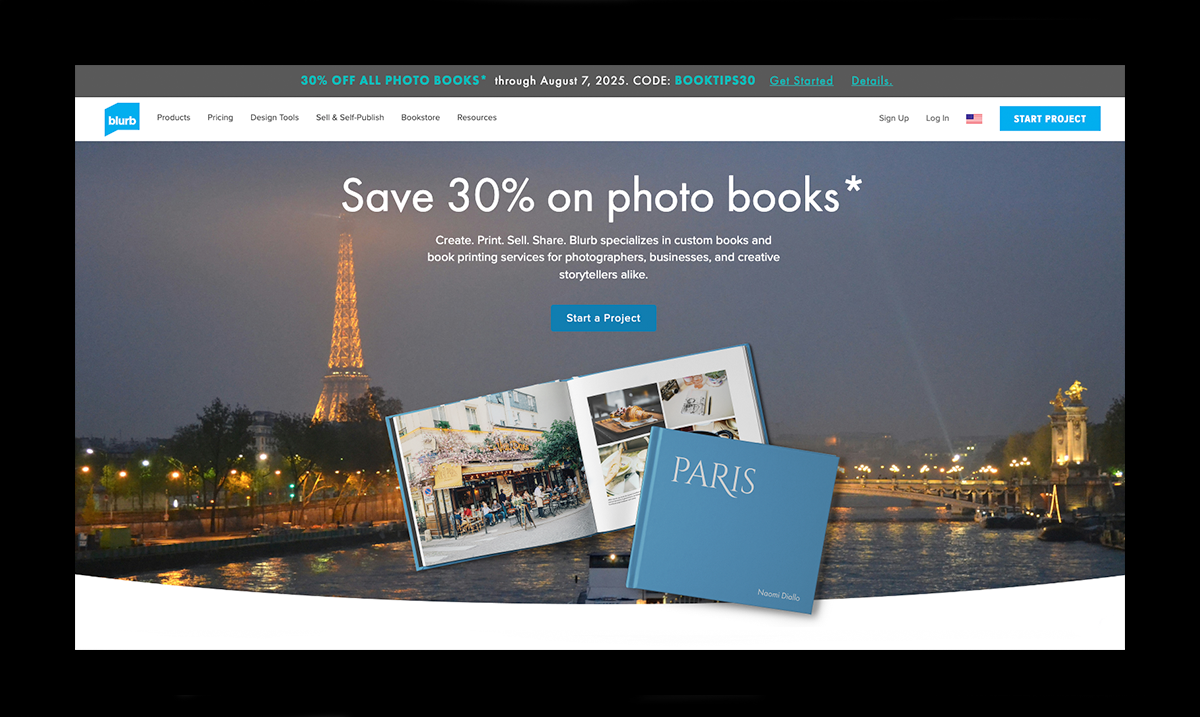
Blurb is excellent for creators who want full control over the design, layout, and publishing of their own photo books, magazines, or print portfolios.
With integrations for Adobe InDesign, Lightroom, and its own free tool BookWright, Blurb supports detailed, complex layouts with a wide range of paper types, cover styles, and customization options.
Whether you're printing a one-off art book or launching a self-published series, Blurb also makes it easy to distribute your work through its own bookstore, Amazon, or Ingram’s global network.
While the platform has a steeper learning curve than more beginner-friendly services, and prices can run high for small orders, the quality and design freedom are unmatched, making it a top-tier pick for creators who want their work to shine.
✅ Pros:
- Ideal for self-publishing high-end photo books, trade books, and magazines
- Advanced customization with tools like Adobe InDesign and BookWright
- Wide selection of paper types, cover finishes, and trim sizes
- Distribution options through Blurb, Amazon, and Ingram
- Supports both print-on-demand and bulk printing for scalability
❌ Cons:
- Steeper learning curve compared to beginner platforms like Shutterfly
- Higher prices for small-volume orders
- Longer production and shipping times depending on order size and format
- Less suited for quick gift-making or casual users looking for templates and presets
10. Picaboo
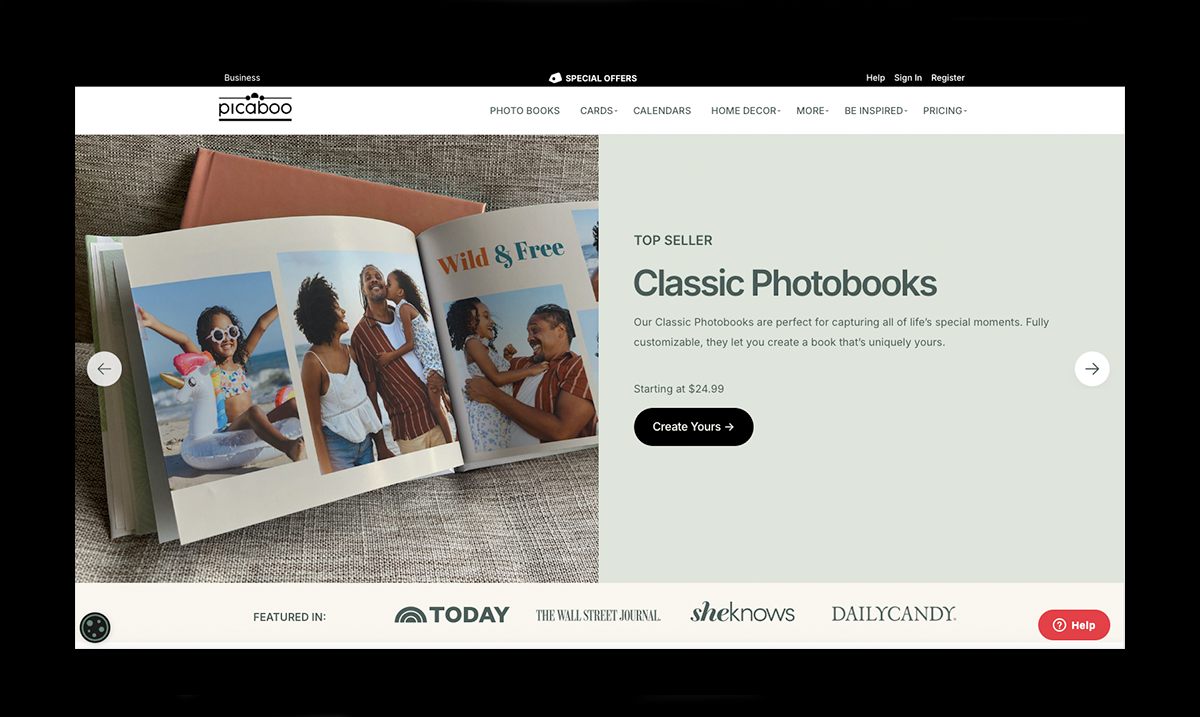
Picaboo is a creative and personal alternative to Shutterfly, offering a wide range of customizable products like photo books, calendars, greeting cards, and home décor.
What makes it stand out is its robust editing platform, giving users far more control over their photo layouts than most casual printing sites.
From adding custom backgrounds, borders, and drop shadows to adjusting brightness, contrast, exposure, and even layering photo elements on the page, Picaboo’s editor lets you tailor every project down to the smallest detail.
It also supports creative elements like filters, shapes, corners, opacity settings, and layering tools, so you can arrange text, stickers, and photos in ways that feel truly unique.
While it may not be the best fit for professional publishing, it is a solid pick for memory-keepers and DIY creatives who want more than just drag-and-drop templates.
✅ Pros:
- Highly detailed editing tools with advanced photo adjustments
- Wide variety of customizable products, including layflat photo books
- Great for users who want creative control over layout and design
- Solid print quality with vibrant color and multiple finishing options
- Works across devices for flexible creation
❌ Cons:
- Interface may feel overly complex for new users
- Production and delivery times can be longer than some competitors
- Less suited for professional publishing or large-volume orders
- No integrated eCommerce or selling features for creators
11. Mpix

As a consumer-facing extension of Miller’s Professional Imaging, Mpix brings lab-grade photo printing to everyday users, offering exceptional color accuracy, sharp detail, and archival durability.
With options like Kodak Endura paper, E-Surface, Metallic finishes, foam core mounting, and custom framing, Mpix delivers prints that not only look stunning out of the box but are built to last a lifetime.
It also offers standout extras like free color correction by photo experts, retouching services, and boutique packaging, making it ideal for gifting or gallery-worthy displays.
While Mpix is more expensive than budget printers like Snapfish or Walmart Photo, the difference in print quality, paper stock, and finishing options makes it a top-tier choice for anyone who wants their images to truly shine.
✅ Pros:
- Exceptional print quality with rich, accurate colors
- Printed on archival-grade Kodak Endura photo paper
- Free expert color correction on all orders
- Dozens of print sizes with options for mounting, framing, and retouching
- Fast turnaround, with most orders shipping within one business day
- Trusted by professional photographers
❌ Cons:
- Higher pricing compared to casual consumer platforms like Shutterfly
- Not ideal for bulk gift printing or casual users on a tight budget
- Limited to photo products; no cards, calendars, or novelty gifts
- No integrated design tools for creating full photo books or albums
12. PhotoBox
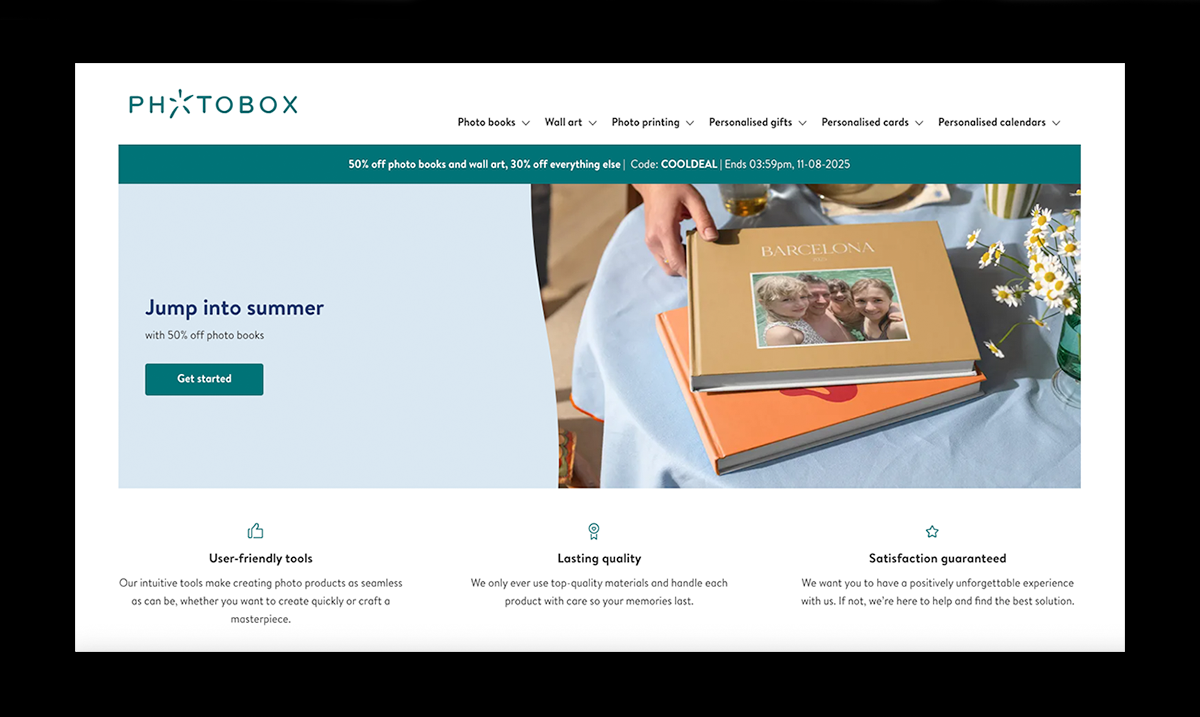
Looking for beautiful, personalized photo gifts without the hassle or high price tag? You might want to give PhotoBox a try.
The platform offers a wide variety of products, including photo books, wall art, mugs, and retro-style prints, with easy design tools anyone can use.
Its Smart Assistant feature helps you automatically select and arrange your best shots, while upgrades like glossy pages, white borders, and layflat spreads add a polished, professional touch.
While the editing tools aren't as robust as pro platforms, PhotoBox keeps things simple and stylish, making it perfect for creators and casual users who want high-quality results with minimal friction.
✅ Pros
- Huge selection of customizable photo gifts and prints
- Easy-to-use editors on mobile, desktop, and online
- Premium paper, glossy or matte finishes, and stylish layouts
- Sleek packaging perfect for gifting
- Smart Assistant and QR upload features simplify the process
❌ Cons
- Design tools aren’t as advanced as some competitors'
- Shipping speed can vary depending on your region
- Photos are only stored for 18 months without a new order
- Not ideal for photographers who need full creative control
13. Amazon Photos
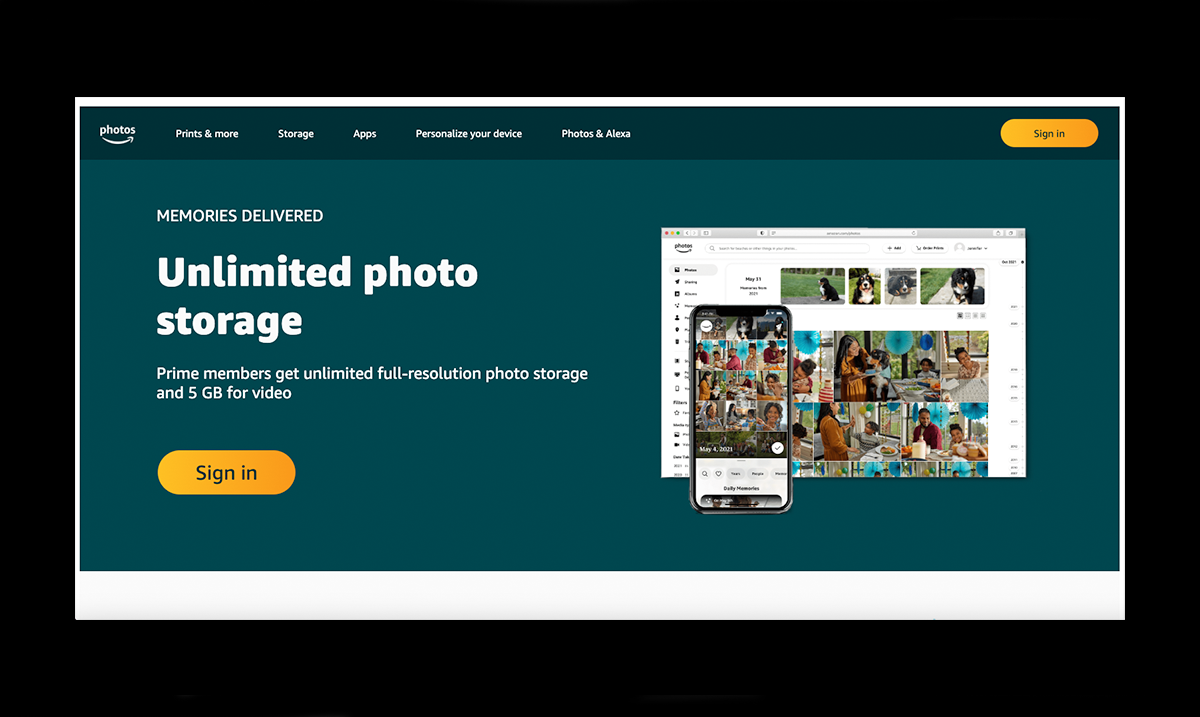
If you're already an Amazon Prime member, Amazon Photos is a surprisingly convenient and budget-friendly way to print your favorite memories.
You get unlimited full-resolution photo storage and 5 GB for video, plus seamless access across all your devices, making it easy to back up, organize, and revisit old moments.
While customization options are limited, and the print quality may not satisfy professional photographers, it's a great option for everyday users who want fast, no-fuss prints at a solid price.
Bonus: you can even personalize your Echo Show or Fire TV with your favorite shots, turning your smart home into a living photo album.
✅ Pros
- Unlimited full-res photo storage for Prime members
- Quick, convenient printing tied to your Amazon account
- Easy backup and auto-save options
- Prints, wall art, and photo gifts available
- Works across mobile, desktop, and Amazon smart devices
❌ Cons
- Basic design tools and limited customization
- Print quality may not meet professional standards
- Product range is smaller than other platforms
Turn Your Photos Into Merch (and Money) With Fourthwall
Got a camera roll full of print-worthy shots?
With Fourthwall, you can transform your favorite photos into sellable products your fans will actually want. No inventory, no stress, and no design headaches.
Whether you're creating wall art, mugs, shirts, or digital downloads, Fourthwall gives you everything you need to build a full-fledged photo merch business. Here's what you get:
- No-code Storefront Builder: Create a fully branded shop that’s 100% yours
- Print-on-Demand Products: Sell framed prints, posters, mugs, apparel, and more
- Global Shipping: Fulfilled fast through partners in the US, UK, EU, and Australia
- Digital Product Support: Upload and sell photo downloads, eBooks, zines, and more
- Flexible Pricing: Set your own margins and keep more of what you earn
- Tiered Memberships: Reward fans with exclusive content and early product drops
- Professional Mockups & Product Peviews: Show off your work with studio-quality images
- No Upfront Costs or Order Minimums: Only pay when you make a sale
- Customer Support Handled for You: Let us take care of the logistics so you don't have to
Launch your photo store with Fourthwall today and start turning your snapshots into products your fans will love!
FAQ: Shutterfly Alternatives
Is Snapfish better than Shutterfly?
Snapfish and Shutterfly are both leading photo-printing platforms, but they serve slightly different audiences.
Snapfish typically offers lower prices and frequent discounts, while Shutterfly stands out for its wider product catalog, premium finishes, and more advanced customization tools.
If you’re focused on affordability and quick reorders, Snapfish wins; for design flexibility and gift variety, Shutterfly still has the edge.
Can I migrate my Shutterfly photos and designs to a competitor platform easily?
Unfortunately, there’s no direct export tool to move your Shutterfly photos or projects to another platform automatically.
You’ll need to manually download your photos and re-upload them to your chosen site (like Snapfish, Mixbook, or Fourthwall) to recreate your designs.
While it takes extra effort, switching platforms can open up new features, better pricing, and more creative freedom.
What are the best alternatives to Shutterfly for printing photo books, wall art, or custom gifts?
Some of the best alternatives include Mixbook, Snapfish, Vistaprint, Canva Print, and Fourthwall, depending on your needs.
Mixbook is great for photo books and storytelling layouts, while Fourthwall is ideal for creators selling custom merch, prints, or wall art online.
Each platform offers unique perks, from bulk discounts to advanced design tools, so it’s worth testing a few before committing.








